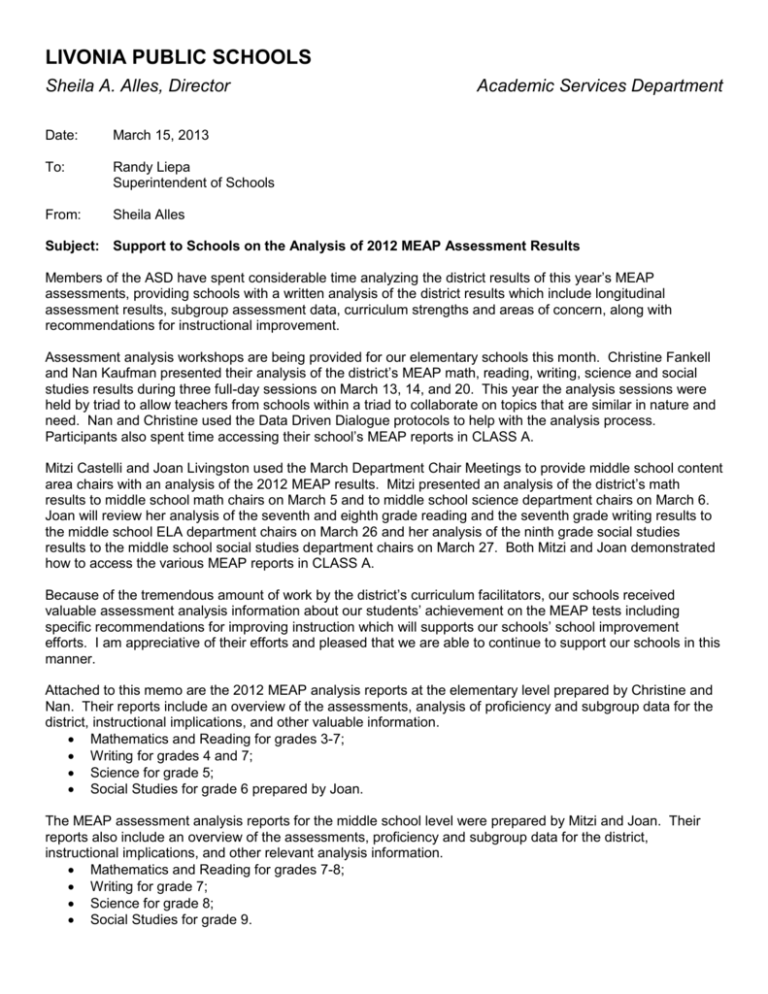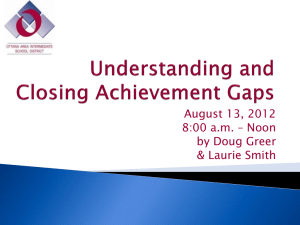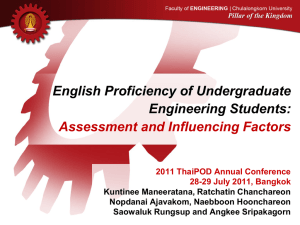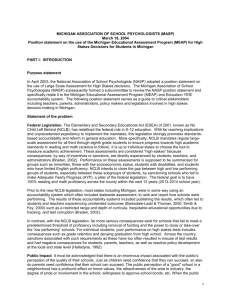Subject: Support to Schools on the Analysis of 2012 MEAP
advertisement

LIVONIA PUBLIC SCHOOLS Sheila A. Alles, Director Date: March 15, 2013 To: Randy Liepa Superintendent of Schools From: Sheila Alles Academic Services Department Subject: Support to Schools on the Analysis of 2012 MEAP Assessment Results Members of the ASD have spent considerable time analyzing the district results of this year’s MEAP assessments, providing schools with a written analysis of the district results which include longitudinal assessment results, subgroup assessment data, curriculum strengths and areas of concern, along with recommendations for instructional improvement. Assessment analysis workshops are being provided for our elementary schools this month. Christine Fankell and Nan Kaufman presented their analysis of the district’s MEAP math, reading, writing, science and social studies results during three full-day sessions on March 13, 14, and 20. This year the analysis sessions were held by triad to allow teachers from schools within a triad to collaborate on topics that are similar in nature and need. Nan and Christine used the Data Driven Dialogue protocols to help with the analysis process. Participants also spent time accessing their school’s MEAP reports in CLASS A. Mitzi Castelli and Joan Livingston used the March Department Chair Meetings to provide middle school content area chairs with an analysis of the 2012 MEAP results. Mitzi presented an analysis of the district’s math results to middle school math chairs on March 5 and to middle school science department chairs on March 6. Joan will review her analysis of the seventh and eighth grade reading and the seventh grade writing results to the middle school ELA department chairs on March 26 and her analysis of the ninth grade social studies results to the middle school social studies department chairs on March 27. Both Mitzi and Joan demonstrated how to access the various MEAP reports in CLASS A. Because of the tremendous amount of work by the district’s curriculum facilitators, our schools received valuable assessment analysis information about our students’ achievement on the MEAP tests including specific recommendations for improving instruction which will supports our schools’ school improvement efforts. I am appreciative of their efforts and pleased that we are able to continue to support our schools in this manner. Attached to this memo are the 2012 MEAP analysis reports at the elementary level prepared by Christine and Nan. Their reports include an overview of the assessments, analysis of proficiency and subgroup data for the district, instructional implications, and other valuable information. Mathematics and Reading for grades 3-7; Writing for grades 4 and 7; Science for grade 5; Social Studies for grade 6 prepared by Joan. The MEAP assessment analysis reports for the middle school level were prepared by Mitzi and Joan. Their reports also include an overview of the assessments, proficiency and subgroup data for the district, instructional implications, and other relevant analysis information. Mathematics and Reading for grades 7-8; Writing for grade 7; Science for grade 8; Social Studies for grade 9. In addition to these analysis reports being distributed at the MEAP analysis session, they were sent to elementary and middle school principals and Student Services Coordinators, and sent electronically to appropriate grade level teachers and ancillary support staff. In addition, the seventh grade reading, writing and math analysis and the eighth grade science analysis reports were given to elementary principals and sixth grade teachers as the content assessed on these tests is taught in sixth grade. Also, Kathy Donagrandi received a set of the attached analysis reports along with MDE provided MEAP reports on district level achievement by content area relative to Students with Disabilities, which were accompanied by a memo from me indicating the support available through the ASD and the collaborative efforts that exist between our two departments. Of course, Andrea Oquist and Steve Archibald received copies of the reports that are relevant to the elementary and secondary levels. Additionally, DOI spent time during recent meetings exploring, analyzing, and discussing the 2012 MEAP results for school improvement purposes. The following statements are a summary of the key insights gleaned from both the curriculum facilitators’ analysis and the DOI review of the MEAP assessment data: The math scores improved in all grades except sixth where the proficiency score dipped. The increase in math proficiency can most likely be attributed to the use of the Everyday Mathematics program in our K-5 classrooms and the realignment of the Connected Mathematics program to the state’s sixth-eighth grade GLCEs. Our reading scores improved in all grades except sixth where the proficiency score declined this year. In looking at the reading scores over a five-year period, it is obvious that our scores are inconsistent from year-to-year and not showing improvement in grades 3-8 as we would expect. We believe this is due to the inconsistent use of research-based, effective instructional practices for teaching reading in grades K-8. A committee of elementary teachers under the leadership of Christine Fankell is piloting Units of Study for Teaching Reading developed by MAISA for third-sixth grades. Joan Livingston is chairing a Middle School ELA Committee whose members are also piloting the MAISA units for reading. These units are aligned to the CCSS for reading. Each grade level has 5-6 units which makes this an enormous and multi-year project which we began last school year. The goal is to revise each of the grade level units based on teacher input and to reflect district-led reading initiatives. I am hoping we will have funds to provide professional development to begin the district-wide implementation of these reading units next school year. Our writing proficiency scores increased in both grades 4 and 7 for the second year in a row. Our proficiency rates are not where we would like them to be which is why we continue to have writing as a District Improvement Goal. Our science MEAP scores decreased in fifth grade for the second year and increased in eighth grade for the second year. Of course, this can be attributed to our science curriculum for grades K-7 only being partially aligned to the state’s GLCEs because we only implemented two of the four BCAMSC units last year. With the full implementation of these units this year, we are looking for improved fifth grade science scores next year. Another influencing factor is our district’s directive to teachers to dedicate significant time to teaching math, reading and writing in the primary grades. Sometimes this occurs at the expensive of teaching science. As a district, it is likely we will include a goal for science in our District Improvement Plan which should have a positive impact on our students’ science achievement. Our social studies MEAP scores are inconsistent in sixth grade and range between 35%-37% over a five year period. In ninth grade, our scores are also inconsistent from year to year and range between 35%-40%. This inconsistency may be due to the limited amount of time and infrequency in which our elementary teachers teach social studies as well as the limited resources available to teach the social studies curriculum at all grade levels. In reviewing student subgroup performance relative to improvement groups noted in our district improvement plan, the following is a brief synopsis of improved proficiency percents for them in the 18 MEAP tests when comparing this year’s results to last year’s: Males improved proficiency performance on 11 tests of the 18 tests and remained the same twice; Females improved proficiency performance on 14 tests and remained the same twice; Blacks improved proficiency performance on 16 tests; Economically Disadvantaged improved proficiency performance on 10 tests and remained the same twice; Students with Disabilities improved proficiency performance on 8 tests and remained the same once. Our district and schools are committed to continuous improvement efforts as part of the school improvement process. MEAP results are one assessment component used in this process. Each year, the district and individual schools analyze the MEAP results to determine curriculum strengths, curriculum areas where growth occurred, curriculum that needs more instructional attention, and instructional strategies that need to be taught. I know many, if not all our schools, will spend time during the May 1, Professional Development Day, reviewing the attached MEAP analysis reports in preparation for developing their school’s school improvement plan for 2013-14. I believe as a district we thoroughly analyze our district’s MEAP results and provide schools with an analysis model and protocols for replication in their schools. The district analysis of the MEAP tests is an essential tool that will be used later this year along with the student achievement results on the Integrated Reading-Writing Assessments and the Mid-Year and End-of-Year Mathematics Benchmark Assessments to update our District Improvement Plan for the 2013-14 school year. Please let me know if you have questions or would like additional information at this time. Attachments C: (memo only) Cabinet Curriculum Faciliators








